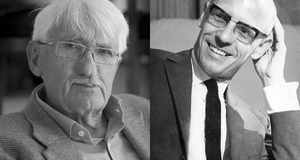Biologization of Capital and Capitalization of Biopower: Connecting Foucault and Marx
By
2021, Vol. 13 No. 05 | pg. 1/1
IN THIS ARTICLE
KEYWORDS
AbstractFoucault raised the concept of biopower in the first volume of The History of Sexuality and placed its emergence in the context of capitalism, but he did not fully tackle the relationship between biopower and capitalism. In this article, the author fills this gap through a careful reading of Foucault and Marx, arguing that perpetual spirals are formed between biopower and capitalism and their techniques intersected on the human body. The author first traces the definitions of each concept in order to show that they can be discussed and drawn connection with each other. After that, he expands upon Foucault’s story of the importance of capitalism for biopower to view capitalism as the historical presupposition of the emergence of biopower and discusses the previously neglected importance of biopower for capitalism in the realms of productivity, population, and differentiation. Finally, their alliance and intertwinement are examined. In the first volume of The History of Sexuality, Foucault raised the concept of biopower, which he regarded as a historical transformation of technologies of power that turned to administration of bodies. He put the emergence of biopower in the context of capitalism and laid out how capitalism facilitated the emergence of biopower, which was the autosexualization of the bourgeois. However, since Foucault focused his analysis on biopower itself, he did not give a full account of the relationship between biopower and capitalism, including the characteristics of biopower that allowed it to be placed in the context of capitalism, the presuppositions and the importance of biopower as well as biopower’s alliance and intertwinement with capitalism. In this essay, I will articulate how each of the aforementioned aspects within the relationship between biopower and capitalism based on Foucault’s original analysis and try to show how their techniques intersected on the human body and formed the perpetual spiral of biopower and capitalism. BiopowerBefore discussing the relationship, I would like to break down the concepts of biopower and capitalism used by Foucault first. Foucault defined biopower to be “the administration of bodies and the calculated management of life” (Foucault, 1978, p140). This definition emphasized “administration” and “management”; that is to say, biopower took the form of governance as opposed to that of absolute prohibition. In order to clarify this distinction, Foucault contrasted biopower against sovereign power. Sovereign power expressed itself through acting as the absolute and final determinant to take away lives, or in Foucault’s words, as “a right of seizure: of things, time, bodies, and ultimately life itself” (Foucault, 1978, p136), which made death the manifestation of its mightiness and ubiquity. Biopower, on the contrary, concerned much less about seizure and deduction than about “working to incite, reinforce, control, monitor, optimize, and organize the forces under it” (Foucault, 1978, p136). In other words, instead of “to take life or let live,” the strategy of biopower became “to foster life or disallow it to the point of death” (Foucault, 1978, p138). More specifically, it aimed at the multiplication and prosperity of lives and endeavored to govern, administrate, manipulate, and control them as living beings, not merely to deduct and prohibit.This essential feature of biopower implied that it found a new way to govern the living beings. Foucault elaborated the techniques of biopower through two concepts: anatomo-politics and biopolitics, both of which were forms of biopower. Anatomo-politics dealt with “the body as a machine” (Foucault, 1978, p139) on the level of individuals. It set a normative and desirable standard of the human body and manipulated every single segment of it, from head to toe, to conform to its standard; by doing so, it enslaved and disciplined the body so that its docility was ensured, its capacities were optimized, its usefulness was maximized. Biopolitics, on the other hand, dealt with “the species body, the body imbued with the mechanics of life and serving as the basis of the biological processes” (Foucault, 1978, p139) on the level of population. It aspired to control “propagation, births and mortality, the level of health, life expectancy and longevity” (Foucault, 1978, p139) so that it could regulate the population as a whole and thus manage its change in every aspect. It is worth noticing that these two basic forms of biopower were not antithetical, but “constituted two poles of development linked together by a whole intermediary cluster of relations” (Foucault, 1978, p139), which could be marked by their mutual effort of normalization. Anatomo-politics normalized the specific behaviors and set of actions of each individual by implementing normative standards and manipulating body segments. Biopolitics normalized the characteristics of the population by intervening in its political and economic determinants. Their combined forces governed bodies and lives both microscopically and macroscopically, which enabled lives to prosper out-and-out and biopower to administrate inside out. CapitalismSince Foucault’s argument focused on biopower, he does not provide a clear definition of capitalism. His conception of capitalism, however, can be deducted from his explanations. First, Foucault argued that the development of capitalism required adjustment in “the machinery of production and…economic processes” (Foucault, 1978, p141) as well as “a stable and competent labor force” (Foucault, 1978, p126), which suggests that capitalism marked a distinction in modes of production as well as the economic system. It had private ownership and wage labor as its material makeup and economic presupposition. Furthermore, that capitalism was a “development” implied that capitalism was neither natural nor always present but developed and constituted itself in human history. Third, Foucault pointed out that there were two classes in capitalism: bourgeoisie and proletariat (Foucault, 1978, p126), indicating that the political peculiarity of capitalism lied in the antagonism between these two classes, in which the former employed and dominated the latter. Moreover, Foucault claimed that “biopower was…an indispensable element in the development of capitalism” (Foucault, 1978, p140-1), which suggests that capitalism was a more comprehensive scheme than biopower that covered every aspect of human lives. In summary, Foucault regarded capitalism as a political, economic, and social system based on private property, labor production, and class opposition developed in history. Features of Biopower: The Basis of Subsequent DiscussionsHowever, while he put biopower into the context of capitalism and regarded it as “an indispensable element,” but he did not explain what traits of biopower allowed it to be discussed in relation to capitalism. I want to fill this gap in two ways. First of all, biopower had specific historical emergence: “starting in the seventeenth century, this power over life evolved…” (Foucault, 1978, p139). That is to say, biopower emerged in a certain historical context, was constituted under certain socio-historical conditions, and was shaped by certain historical forces. It was not, as Agamben (1998) argued, an eternal and unchanging form of power. Such historical constitution allowed it to be contrasted with capitalism, which was also historically constituted; the reasons, effects, processes, changes, actions, and forces of their emergence and development could be examined in the history. It is worth noticing that Foucault’s notion of “biopower,” as aforementioned, emerged in the 17th and 18th centuries, the same time period capitalism emerged, which means that the discussion of biopower already presupposed the context of capitalism. And their shared historical period means that there were possible interactions and/or mutual causations between them. Furthermore, biopower dealt with technologies, strategies, and techniques of power while capitalism with political, economic, and social systems. They were not antithetical concepts that did not fit with each other but dealt with different levels and aspects of the social regime. This is to say, they could be discussed in the same context and related to each other. The Importance of Capitalism for Biopower: Foucault’s StoryIn the last two chapters of The History of Sexuality, Foucault gave his own story of their relationship by identifying the periodization of the deployment of sexuality, an essential part of biopower. The deployment of sexuality, Foucault argued, “went back a long way,” but had a significant transformation into new technologies in the “eighteenth century” (Foucault, 1978, p115-6), which refers to the emergence of biopower. He pointed out that there were two essential features of this new technology that distinguished them from the previous one. One was that “it escaped the ecclesiastical institution” (Foucault, 1978, p116) and started to operate through secular principles. Although it inherited the techniques from Christianity, it managed to utilize and transform those methods through non-religious discourses and schemes. The other feature was that the new technology “expanded along three axes” (Foucault, 1978, p116): pedagogy, which focused on the sexuality of children; medicine, which dealt with the distinctive characteristics of female sexuality; demography, which administrated all aspects of the population. Since this transformation of sexuality involved the significant change of power from its juridical form to a biological form, i.e., the management and administration of life, it also marked and represented the emergence of biopower. Moreover, Foucault claimed that this historical transformation emerged at first not as a tool of repression, but rather as self-identification and self-protection of the bourgeoisie. The fact that “the most rigorous techniques were formed and, more particularly, applied first, with the greatest intensity, in the economically privileged and politically dominant classes” (Foucault, 1978, p120) revealed that this new form of power did not mean to repress and prohibit the lower classes at first, but only to satisfy the needs of the privileged classes. There were two facets of their needs. First, the nobility and distinction of the bourgeoisie were no longer marked by their ancestries and blood, so they had to find a new way of distinguishing themselves, which was the new “sexuality.” With a complete, eugenic, and normalized notion of sexuality and thereby a “class” body “with its health, hygiene, descent, and race” (Foucault, 1978, p124), the bourgeoisie managed to self-affirm themselves among the population against other lower classes. Second, in order to maintain their political and economic hegemony, the bourgeoisie must improve their physical conditions. They aimed at an “indefinite extension of strength, vigor, health, and life” (Foucault, 1978, p125) so that they could control, rule, multiply, prosper and sustain their dominance. In short, the bourgeoisie, the privileged class in capitalism, for the purpose of self-identification and supremacy, auto-sexualized themselves and reached “the endogamy of sex and the body” (Foucault, 1978, p124). The techniques they applied to themselves later “extended to others…as a means of social control and political subjugation” (Foucault, 1978, p123). Thus, it was capitalism, especially the bourgeoisie as its representative, that gave rise to biopower, particularly the new technologies of sexuality as its major form. The Importance of Capitalism for Biopower: Foucault’s IncompletesAs previously mentioned, Foucault identified several important new features of sexual technologies and biopower, including secular institutions, pedagogy, medicine, and demography, but did not explain how these features came to realize. I believe that none of these new features of biopower could be possible unless under capitalism, and, in this way, capitalism was the historical presupposition of the emergence of biopower. First of all, capitalism organized production on the level of human existence. On one hand, the wage labor of capitalism dealt directly with the human body. Under the universal principle of private property, proletariats could not maintain their subsistence unless they themselves enter the workforce and get paid for their physical labor. In this way, their bodies were fully subject to control by the factories, assembly lines, Taylorism, and the endeavor to increase productivity. Using Foucault’s words, capitalism operated through “the controlled insertion of bodies into the machinery of production” (Foucault, 1978, p141). Thus, the control of the body in capitalist production allowed the formation of such a power that directly manipulated and subjugated human bodies. On the other hand, capitalist production followed only the principle of self-interest and market exchange and aimed solely at capital accumulation and exploitation of surplus value. Such simple and univocal objective destroyed all of the “sentimental veil[s]” covered on the “feudal, patriarchal, idyllic” and familial, religious, occupational relations and reduced them to “a mere money relation” (Marx et al., 1972, p476). As Marx puts it, “all that is solid melts into air, all that is holy is profaned” (Marx et al., 1972, p476). The historical deterioration of non-capitalism relations, brought by the mode of production of capitalism, freed power from religious foundations. Both aspects of capitalist production dismantled the previous fixed and frozen social conventions, especially religious institutions, and opened up a new space for power to directly manipulate the human body through secular regimes. The division of labor brought by the development of capitalism was the presupposition of pedagogy and medicine. Although the division of labor started to develop long ago, capitalism drastically intensified it into every aspect of society. Capitalist production, in the first place, required division of labor to an extreme extent in order to reach supreme productivity, which was expressed through the individual jobs on the assembly lines and subdivided occupations. Since the material production was subdivided, other realms of society, including social, cultural, and ideological production and reproduction, also started to evolve towards subdivision. In particular, specific domains of knowledge and academic disciplines that were mutually independent replaced the general and onefold mode of social reproduction. It was in this context that the specialized scientific fields, like pedagogy, which specifically focused on the education of children, and medicine, which autonomously prescribed the problems of human bodies, emerged. Such emergence of independent fields allowed power to be integrated into specialized domains of social reproduction and express itself in a professional, scientific discourse, thereby implementing peculiar administration techniques to control the human body and human life. Capitalism also induced the appearance of the concept of population, which is the presupposition of demography. Since factories could not operate without a large number of workers, capitalist production required a cluster of people. Driven by the economic interests of wage and capital accumulation, lots of people started to concentrate from rural areas to cities and towns, where the exchange of commodities was much more convenient, and the markets were much more developed. This centripetal movement was enabled, facilitated, and intensified by “means of communication that are created by modern industry” so that people could achieve the level of centration, which “the burghers of the Middle Ages…required centuries” to attain, “in a few years” (Marx et al., 1972, p476). More importantly, such a cluster of people could be easily separated into different groups, notably the bourgeoisie and the proletariat, which allowed the population to be differentiated and analyzed in detail. This appearance of population brought by capitalism gave rise to the discipline of demography, which analyzed, conducted calculation upon groups of people, and thus allowed biopower to examine and prescribe different aspects of population, including its increase and decrease, fertility and mortality, health and illness, thereby subjugating it as a whole. In short, the new features of biopower mentioned by Foucault, secular institutions, pedagogy, medicine, and demography, could not have existed without the development of capitalism and its production. Capitalism, therefore, is the historical presupposition of biopower and thus essential and indispensable to biopower. It is worth noticing that here I do not intend to dispute Foucault against his argument about the origin of biopower that the bourgeoisie invented the new technologies of biopower and applied them to themselves first but only aims to supplement his story by showing that capitalism presupposed the elements of biopower he identifies. The Importance of Biopower for CapitalismBesides his major argument above, Foucault also pointed out that “this bio-power was without question an indispensable element in the development of capitalism; the latter would not have been possible without” (Foucault, 1978, p125-6) the former, which suggested that the relationship between capitalism and biopower was not unidirectional, but mutually beneficial. Biopower, though was not a presupposition as capitalism was for it, was still crucial and fundamental for capitalism. However, Foucault only articulated the importance of biopower to capitalism very briefly in two paragraphs. I will summarize his idea into three points, i.e., ensuring productivity, controlling population and differentiation, and explain and elaborate them in detail. Right after Foucault made the claim, he said that capitalism “would not have been possible without the controlled insertion of bodies into the machinery of production” (Foucault, 1978, p141), which indicated that one of the most important contributions of biopower was to maximize productivity. It was true that capitalism, with its universal principle of private property and wage labor, had already forced people to enter the workforce, “but this was not all it required” (Foucault, 1978, p141). It desired absolute conformity of human body together with increasing output, which required “methods of power capable of optimizing forces, aptitudes, and life in general without at the same time making them more difficult to govern.” (Foucault, 1978, p141) Biopower, especially the anatomo-politics within it, fulfilled this historical task. The indefinite lines of penetration, for example, dealt with the sexuality of children, especially masturbation. On one hand, they penetrated children’s behavior of masturbation by “tracing them to their source, tracking them from their origins to their effects, searching out everything that might cause them or simply enable them to exist” (Foucault, 1978, p42), in a word, thoroughly examining body actions. On the other hand, they transformed certain institutions, including the pedagogization in the grade schools and the surveillance by the parents, placing the object under constant control. In this way, masturbation was analyzed, examined, and normalized. Every action was under subjugation and one would learn to act according to the normalized standards. Such a technique of lines of penetration did not only apply in the field of sexuality, but also in production. Anatomo-politics, using the same technique, analyzed, examined, surveilled, normalized the working bodies. Bodies of the workers were adjusted to speeding assembly lines, long-lasting working hours, and strict quality requirements. Hence, as Foucault postulated, the requirements of productivity maximization were fulfilled: the availability and docility of body were achieved, a stable and competent labor force was formed. Another basic requirement of capitalist production was the “growth of human groups” (Foucault, 1978, p141), i.e., controlled population. This was because the continued expansion of capital and scale of production required an extra workforce. Of course, it did not mean a pure increase in population, but a regulated increase together with proper management so that the elements of the population could be fully in accordance with the “the expansion of productive forces and the differential allocation of profit,” which “were made possible in part by the exercise of bio-power in its many forms and modes of application.” (Foucault, 1978, p141) Biopolitics intervened and regulatorily controlled “all the conditions [of the population] that can cause [it] to vary” (Foucault, 1978, p139). It controlled the fertility and mortality rate of the population so that the number of people, i.e., the size of the workforce, could be adjusted based on the need for production. It directly managed the health condition of the population so that there would enough people who were able to work. It set up various institutions – “universities, secondary schools, barracks, workshops” (Foucault, 1978, p140) so that any problem of the population could be efficiently solved, any potential uprising could be dismantled, and species bodies would have sufficient knowledge, skills and capacities to work. As a result, the population which was under the utter control of biopower perfectly conformed to the requirements of capitalism. Foucault also talked about yet another demand of capitalism, “segregation and social hierarchization” (Foucault, 1978, p141). As previously mentioned, capitalism was based on the class distinction between the bourgeoisie and the proletariat as well as the employment relationship between them. In such a system, the bourgeoisie endeavored to “guarantee relations of domination and effects of hegemony” (Foucault, 1978, p141) for generations. To do so, the bourgeoisie had to, firstly, separate themselves from others by assigning and attaining distinctive characteristics, secondly, establish social institutions to justify such characteristics, and thirdly, prevent contamination. The first task, as previously mentioned, had been completed with the deployment of sexuality, through which bourgeoisie self-affirmed and self-identified. Biopower aided the other two tasks. For justification, the professionality of pedagogy and medicine ideologized and politicized distinctions between classes, including their differences in sex, body, and physical condition, through scientific and normalized discourses, which served to turn political and economic advantages into eugenic, innate, and unchangeable human nature. As for preventing contamination, biopower applied its expertise in demography to segregate the population into groups (classes) of people. It strived to fixate different classes in different residence areas, which aimed to physically separate “class” bodies, provide unequal medical treatments, which affected the health and longevity of different classes, and arrange stratified educational institutions, which could transform temporary wealth to categorical inequality. Consequently, a social hierarchy was induced and stabilized by biopower and ensured the proper social convention for the development of capitalism, i.e., bourgeoisie hegemony. From these three points, we can see that the functions of biopower were necessary in the course of the development of capitalism. As Foucault put it, “the investment of the body, its valorization, and the distributive management of its forces were at the time indispensable” (Foucault, 1978, p141). To summarize, biopower and capitalism were important to each other: the social arranges brought by the latter were the presupposition of the former; the former in turn guaranteed and maintained the latter. Neither of them could have survived without the other. I want to again emphasize that their interaction centered around the human body. Capitalism changed the way of using the body: it exploited the body as an economically profitable object and marked the body as a political class emblem. Biopower changed the way of manipulating the body: it viewed the body as a living being to be governed, not a thing to be reduced or terminated, and subjugated the body in both individual and population scales. The jurisdictions of capitalism and biopower, the economic and political system, and the technology of power, intersected at the human body. From this point of view, we can go further into their relationship and see how they allied together in the field of the human body. Alliance and Intertwinement Between Biopower and CapitalismTheir alliance could be reflected by their truth discourse of body. They together imposed a set of social discourse that appeared as something truthful and justified both of them. Capitalism turned techniques of biopower and its penetrating control of body into a market principle, namely: wage labor is voluntary; all capital accumulations are public and fair price mechanisms. By disguising forms of power as economic processes, it limited the disagreements and insurrections against biopower’s control, thereby minimizing its cost. Biopower also created a discourse in which the normal way of living, the normal condition of the human body, and the normal character of classes were defined so that the alienated bodies in capitalist production were seen not as miserable, but normal and even desirable. Thus, the social discourses imposed by capitalism and biopower, which designated a normalized and seemingly truthful notion of body, interactively helped to conceal the wretched conditions and subjugation they brought. Furthermore, they advanced the objectification of the human body on the level of the social system as a whole. Capitalism extended its rule of private property to every single facet of society, including and especially the human body, which became a commodity that was economically beneficial and subject to market principles to be traded, contracted, and exchanged. Biopower viewed the human body on the level of objects as well: it is reduced to the numbers in population statistics, vessels of manipulation and subjection, and riddle to be examined and uncovered. Their combined effort objectivized the human body, depriving its essential feature, i.e., the embodiment of human thoughts, and its essential evolution, i.e., free and full-scale development. Last but not least, capitalism and biopower intertwined with each other: there was a process of capitalization of body and biologization of capital. It was not just that the body was a commodity, but that the body, together with its function, private information, and potentiality, had become capital itself. It is a subject not only to be reinforced, incited, optimized, but also to be coded, multiplied, publicized, uncovered for the purpose of capital increment. Therefore, there started to emerge the trade of not only human but also body information, and the transaction for not only labor but also future life. On the other hand, capital stepped into the field of biopower and reformed itself as bio-capitalism, which emphasized bio-industry and bio-technology. Considering the focus of this essay, I will just give a brief example here. Literatures have shown that numerous transnational companies were using their monopolized bio-technology to extract bio-resources from Africa by exploiting local people (Kirkpatrick & Nixson, 1981). These transnational companies were an evident example of how the human body and bio-materials had been capitalized. ConclusionIn summary, Foucault raises the concept of biopower as a power to administrate body and life instead of putting to death. There were several underlying implications of Foucault’s notion of biopower, including its historicity and conceptual space, which allowed biopower to be discussed in relationship with capitalism. He talked about biopower in the context of capitalism and successfully showed that capitalism, particularly the bourgeoisie, gave birth to biopower in order to affirm and extend bourgeoisie hegemony. On the basis of this, I categorized his scattered arguments about their relationship and demonstrated that capitalism was the historical presupposition of biopower and that biopower was a crucial stabilizer of capitalism. Their practices intersected on the human body and made it an object of subjugation. At last, I explored further in their relationship and found out that their interaction did not limit in the time period of their establishments but intensified greatly afterward. They allied with each other, operated towards shared objectives using intertwined techniques, and reached the capitalization and biologization of society. There was not only “perpetual spirals of power and pleasure” (Foucault, 1978, p45) , but also perpetual spirals of biopower and capitalism, continuously integrating and consolidating each other. It is reasonable to imagine that there would be more complicated and sophisticated interplay of biopower and capitalism in the future, which might exert power on human body in more disguised and manipulative ways. ReferencesAgamben, G., & Heller-Roazen, D. (1998).Homo sacer: Sovereign power and bare life. Stanford: Stanford University Press. Davidson, A. (2001).The emergence of sexuality: historical epistemology and the formation of concepts. Cambridge, Mass: Harvard University Press. Foucault, M. (1978).The History of Sexuality: Volume I-An Introduction. New York: Pantheon Books. Foucault, M. & Lotringer, S. (1996).Foucault live: (interviews, 1961-1984. New York, N.Y: Semiotext. Foucault, M. & Rabinow, P. (1997).Ethics: subjectivity and truth. London: Allen Lane. Kirkpatrick, C., & Nixson, F. (1981). Transnational Corporations and Economic Development.The Journal of Modern African Studies,19(3), 367-399. doi:10.1017/S0022278X00014932 Marx, K., Engels, F., & Tucker, R. C. (1972).The Marx-Engels reader. New York: Norton. Suggested Reading from Inquiries Journal
Inquiries Journal provides undergraduate and graduate students around the world a platform for the wide dissemination of academic work over a range of core disciplines. Representing the work of students from hundreds of institutions around the globe, Inquiries Journal's large database of academic articles is completely free. Learn more | Blog | Submit Latest in Philosophy |


















